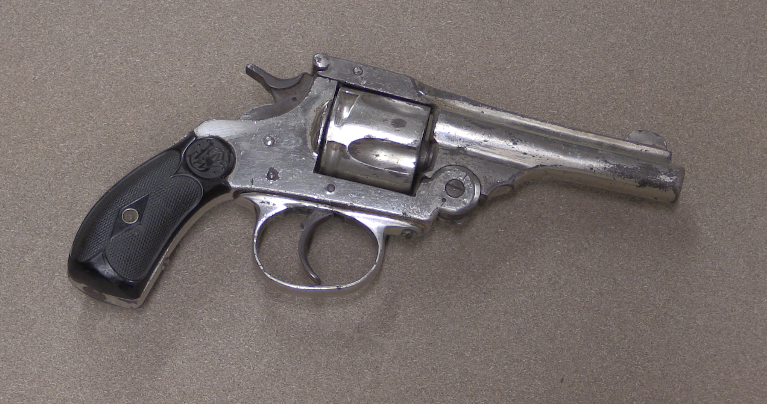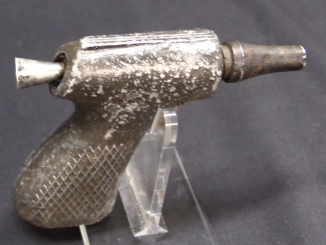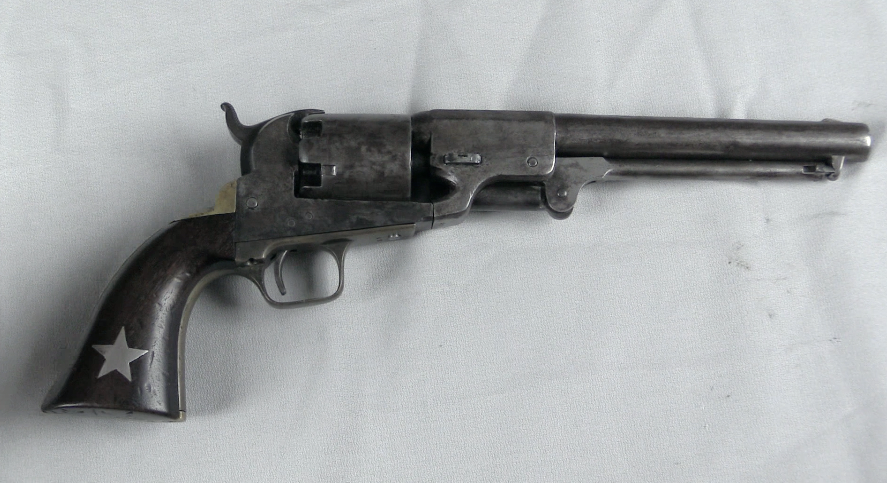Orvill Robinson was a gunsmith and gun designer in upstate New York who developed two rather interesting rifle designs in the 1870s. They are both pistol-caliber actions, with tubular magazines. The first (the 1870 model) used a tilting wedge very similar in concept to the 1886 Mannlicher straight-pull action. This Robinson design had a pair of checkered tabs on the back of the bolt, and the shooter would use them to manually cycle the bolt back and forth.
The later 1872 pattern rifle abandoned the earlier action for a toggle type of lock, operated manually with a small knob on the side of the bolt. The shooter would use it to pull the bolt open and push it closed. Much like a lever action, but without the lever.
Both guns seems to have had significant promise, which may explain why the Winchester company was interested in buying out Robinson in 1874. They purchased his inventory and patents, and Robinson signed a non-compete contract to boot. Winchester shut down the production; they were not interested in having a viable competitor to their lever-action rifles. Whether Ferdinand Mannlicher ever saw one of the 1870 pattern rifles is unknown, but it could have been the basis for his early 1886 action…




Possibly the gates on the action sides were used for loading/unloading?
The iron frame rifle appears to have an offset hammer. Rimfire?
.38 RF if you follow the link to RIA.
Wow, I could imagine US Soldiers using this. Probably all the way up to the early 1890s…
Was the toggle an inspiration for any of the toggle actions of the next 40 years? Was it the first firearms application?
“Was the toggle an inspiration for any of the toggle actions of the next 40 years? Was it the first firearms application?”
Does SPENCER REPEATING RIFLE counts as toggle?
Can be Robinson’s action scaled-up for bigger cartridge without excessive gain of mass, how heavy would be say .45-70 rifle utilizing Robinson action?
No. The Spencer is actually an example of that large family known as “falling block” actions. Which actually have very few members that really qualify as such.
The Sharps, with its block moving straight up and down in a mortise, is a “true” falling-block. The British Alexander Henry (not to be confused with B. Tyler Henry) is another such, as is the Portuguese Guedes.
The Spencer, along with the Starr single-shot, is an example of a front-pivot “hinged” or “rotating” type “falling-block”. The Peabody, Peabody-Martini, and Martini-Henry are rear-pivot dropping-front type “falling blocks”, as is the Bavarian Werder “Lightning”.
All of the above are considered “falling blocks”, but they are actually two different types, one moving straight up-and-down, the other pivoted at one end or the other and describing a segment of a circle as it moves.
What looks sort of like a “toggle” on the Spencer is actually the spring-loaded “finger” on top of the breech, that first guides the round being brought up from the magazine tube int the chamber (keeping it from popping up and out of the breech), and when the breech is in the full “down” (open) position, acting a a ramp to ensure that when the extractor/ejector arm throws the round out of the chamber, it actually goes up and out instead of falling back into the breech.
This piece is not actually connected to the breechblock, it just “rides” up and down on the breechblock, driven by its own spring. Hence the term “spring finger”.
“Falling blocks” are an interesting field of study. And one that can give you severe migraines if you think about it too much.
cheers
eon
For me knob on later version looks to be too small, compare to bolt-action repeaters.
Try to imagine usage in winter gloves.
“Whether Ferdinand Mannlicher ever saw one of the 1870 pattern rifles is unknown, but it could have been the basis for his early 1886 action…”
It is quite possible considered that Ritter von Mannlicher:
During the visit of the Centennial exhibition in the USA in 1876 Ing. [Ingenieur] Mannlicher had the chance to study several plans and models for small arms at the Patent office of Philadelphia for some days, possibly a valuable inspiration for his first rifle model which was offered to the k.k. [kaiserlich und königlich] technical administration military committee in 1879.
source: http://www.austro-hungarian-army.co.uk/biog/mannlicher.htm
Personally I think Mannlicher was one of most important designers in fire-arms history.
One point on a patent is that you can order a copy. So why not Mannlicher. Or every other gun designer.
I’m wondering if Robinson wasn’t groping his way toward a basic self-loading action. It seems to me that what’s missing from both of his designs is an external power system to operate the breech (other than the shooter’s hand) and a separate means of returning the bolt in each to battery.(i.e., a recoil spring.)
The devices to vary the length of cartridges to be deposited on the lifter really only makes sense if he was thinking of either (1) various loads with varying bullet extruded length or (2) various cartridges with different OALs. The latter would make more sense, as most rounds then had fairly similar OALs within caliber (.44-40, etc.) regardless of bullet type.
However, with interchangeable barrels, this setup could easily accommodate various cartridges with the same head diameter. Like .44-40 and .38-40, for instance.
As for “external power”, either one could easily be made into a pump-action, either Spencer (forearm) or Burgess (pistol-grip) type. Or, for that matter a self-loading action. The idea was already out there; see “Regulus Pilon”- he patented a recoil-cocked, self-extracting rifle action in 1863, and at least one prototype still exists.
The “ears” on the bolt of the 1872 model seem well-designed to “rack” the action of a self-loader. And the knob on the toggle of the 1874 is similarly reasonable to do the same to a toggle-lock.
Neither one would be very good for repeated cycling of a manually-operated action in field conditions, especially in cold or wet or when wearing gloves. But as for loading the first round up or clearing a dud or jam, they would be no more aggravating than an AR-15 or a Parabellum. Rather less than the latter, actually.
(Yes, I’ve done a “tap-rack-BANG” on a P.08, wearing gloves. Not fun.)
I’m actually bit surprised that Winchester didn’t follow up on the toggle-lock design, at least. Although the resemblance to a couple of Carl Ehbets’ early self-loading pistol actions at Colt is noteworthy.
Hmmm…
cheers
eon
Black powder residue would foul up the action pretty soon. Smokeless powder is one of the prerequisite for self loading.
“Smokeless powder is one of the prerequisite for self loading.”
Maxim gun (which is full-auto, so it should clog with powder residue even faster) were used with black-powder cartridge and it worked
The 1890 Pitcher semi-auto rifle had exactly this problem, but still in the vein I think.
Pump-actions are not really all that easy to come up with. There are several issues that need to be addressed that just don’t come up with a bolt or lever gun. One is the action-bar-lock. A pump-action needs to lock up so it can’t be opened even when the hand holding the pump-handle is pulling the gun into the shoulder. These typically unlock when you pull the trigger, but you don’t want the gun to immediately unlock the moment the hammer falls, there needs to be a delay mechanism so you don’t pull the gun out of battery the moment of ignition. Add to that the lack of primary extraction leverage and all the issues of tube-fed guns in general, (cartridge stops and lifter timing), and you get a very complex system indeed.
I don’t know what these guns are like inside, perhaps there is something about them that Winchester thought innovative enough to buy them out, but I suspect their main advantage over a Winchester was that they were a cheaper-to-manufacture alternative to a lever operated repeater and were bought out to eliminate a down-market product.
Okay, trying to sum up my thoughts here on improving the Robinson Rifles…
1. Eliminating the adjustable head-spacing issue by first having standardized ammunition
2. Replacing the tubular magazines with box magazines for more reliable feeding
3. Improving safety by accounting for ruptured cases (think G.98 style venting holes)
4. 1870 model could use a bolt return spring if only to shorten the bolt stroke time on manual operation
5. 1872 model could use a tilting bolt lockup to avoid backfiring rather than use the hammer as a locking piece
6. both rifles need charging handles which can be grabbed in muddy field conditions and operated with ease
7. both rifles need hand-guards or fore-stocks (you want to burn your hand on a hot barrel?)
Did I get anything wrong?
The only thing I’d quibble with is a box magazine with rimmed cartridges. Having grown up with an SMLE No 1 Mk III (still had the magazine cutoff they left off the MK III*), and later owning a 91/38 Mosin Nagant carbine in 7.62 x 54R and an 0.303in No. 4, I can attest to the fact that rimmed cartridges are a huge PITA in any sort of box magazine.
In fact, one reason Savage developed their proprietary rimless cartridges for the Model 1899 lever action was exactly to avoid having to fool around with rimmed rounds in their rotary magazine.
A tubular magazine is probably the best and most reliable feed system for rimmed cartridges there is. The only way you really can screw up putting the rounds in the magazine is inserting them bass-ackwards. (Don’t laugh, I’ve seen people do it.)
But rimmed rounds have to go into a box magazine exactly right, each one with its rim in front of the rim below it and behind the one above it, or it jams, period. Also, very few box magazines loaded with rimmed cartridges work consistently at full rated capacity. (The SMLE is happiest with only eight rounds in it, in my experience.)
As for adjustable “head spacing”, it was the available length of the lifter (feed tray) that was being adjusted, not headspace. And being able to adjust headspace can come in very handy; for instance, when installing and zeroing a new, factory-fresh barrel on an M2HB.
An adjustment to the lifter’s accommodation length would make very good sense on a rifle intended to have interchangeable barrels in different chamberings. (See Mauser Model 66 bolt-action.)
On a rifle in a single caliber, other than wanting to “fine tune” the feed for differing cartridge OALs due to bullet styles, it seems like an unnecessary complication.
cheers
eon
Point taken. If we had rimmed rounds, go for the tube. If rimless, go for box…
“If we had rimmed rounds, go for the tube.”
Tubular is viable solution as long as you use round-nose or flat-nose bullets. Also so far tubular magazines are fixed, so if you want empty rifle to full load you need more time than if you have to load from clip or by switching magazine to loaded one.
“The only way you really can screw up putting the rounds in the magazine is inserting them bass-ackwards. (Don’t laugh, I’ve seen people do it.)”
Observation: some users ALWAYS will find improper way of operation
“In fact, one reason Savage developed their proprietary rimless cartridges for the Model 1899 lever action was exactly to avoid having to fool around with rimmed rounds in their rotary magazine.”
Arguable
rotary magazine can handle rimmed cartridge well if designed from start, it can be designed so each cartridge don’t touch each other, see 2nd image from top here:
http://firearmshistory.blogspot.com/2014/06/rotary-magazine.html
of course if you use rimless cartridge you can allow touching (see M1941 Johnson rifle), for recent example of rotary-magazine for rimmed cartridge see Ruger 77/357
“If we had rimmed rounds, go for the tube.”
Pan magazine is also good option, I don’t know about any problems with Lewis machine-gun caused by magazine. DT machine gun magazine also work well.
Anyway I would say: if want rimmed cartridge use belt-fed or tray-fed (like in Hotchkiss Portative)
While a rimmed cartridge presents certain challenges for box magazine design (and belt feed design as well) and may require some extra care when loading the magazines, there has been many semi- and full-auto guns chambered for a rimmed cartridge (especially .303 British or 7.62x54R) that work just fine with a box magazine. I probably don’t even have to give examples, since they are so many… When considering magazine reloading, we have to remember that usually detachable magazines for full-auto weapons are not reloaded during combat. Sometimes one may have to do that, but usually an LMG team tries to carry enough loaded magazines to last through the active phase of combat.
Ian I was wondering since you mentioned the Mannlicher rifle in this, could you maybe do a video explaining it in more detail and disassemble it for us?
At some point, yes. I do have an 1888/90 Mannlicher in my own collection.
I really love the way these designs allowed the user to adjust for catridge length!
IIRC Mannlicher sued Burgess for using the pivoting locking bolt in Burgess’s design. Mannlicher had patented the design in the US and Europe.
I found the U.S. patents for these guns:
The 1870 model:
http://www.google.com/patents/US103504
The 1872 model:
http://www.google.com/patents/US125988
How on Earth did you find this after Google tagged it under “Obvill M. Bobinson”. haha. Nice find.
mr jatt Mp3 New Punjabi Song,Single Tracks Latest song download also Listen Latest Music Albums Online in High Quality at Mrpendus.in
mr jatt
Thanks For This Great Article. May You Bring This More in Future. Mplyrics